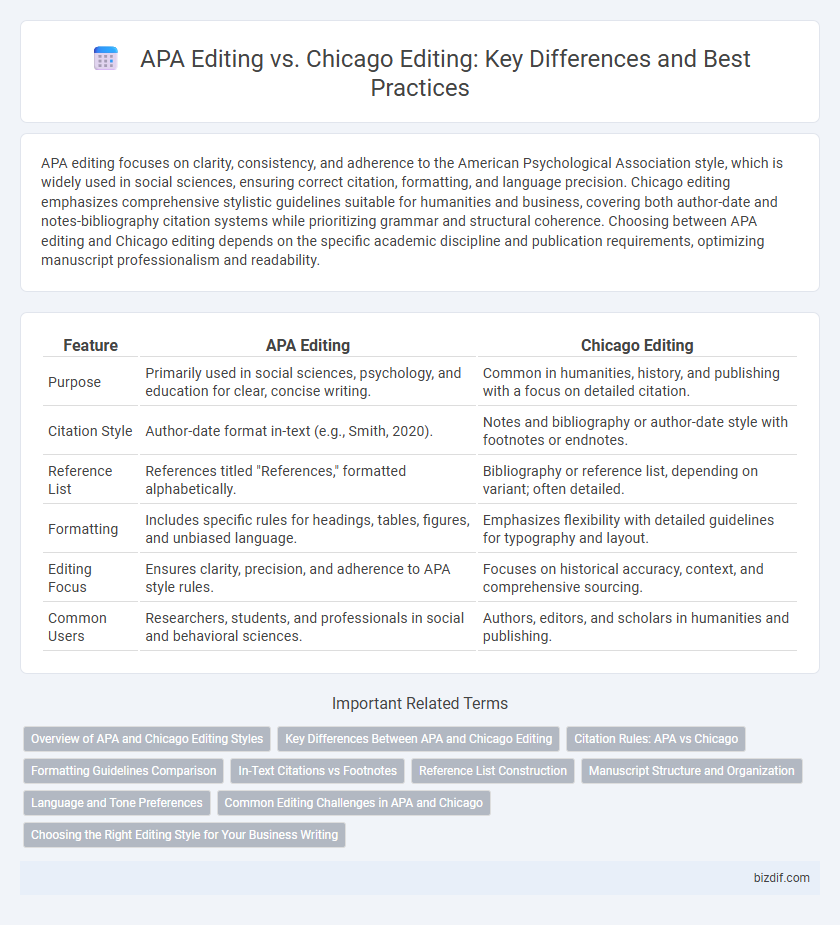APA editing focuses on clarity, consistency, and adherence to the American Psychological Association style, which is widely used in social sciences, ensuring correct citation, formatting, and language precision. Chicago editing emphasizes comprehensive stylistic guidelines suitable for humanities and business, covering both author-date and notes-bibliography citation systems while prioritizing grammar and structural coherence. Choosing between APA editing and Chicago editing depends on the specific academic discipline and publication requirements, optimizing manuscript professionalism and readability.
Table of Comparison
| Feature | APA Editing | Chicago Editing |
|---|---|---|
| Purpose | Primarily used in social sciences, psychology, and education for clear, concise writing. | Common in humanities, history, and publishing with a focus on detailed citation. |
| Citation Style | Author-date format in-text (e.g., Smith, 2020). | Notes and bibliography or author-date style with footnotes or endnotes. |
| Reference List | References titled "References," formatted alphabetically. | Bibliography or reference list, depending on variant; often detailed. |
| Formatting | Includes specific rules for headings, tables, figures, and unbiased language. | Emphasizes flexibility with detailed guidelines for typography and layout. |
| Editing Focus | Ensures clarity, precision, and adherence to APA style rules. | Focuses on historical accuracy, context, and comprehensive sourcing. |
| Common Users | Researchers, students, and professionals in social and behavioral sciences. | Authors, editors, and scholars in humanities and publishing. |
Overview of APA and Chicago Editing Styles
APA editing emphasizes clarity, conciseness, and uniformity, commonly used in social sciences with specific guidelines for in-text citations and reference lists. Chicago editing, favored in humanities and publishing, offers two systems: notes-bibliography and author-date, providing flexibility in citation format and detailed source documentation. Both styles demand meticulous attention to grammar, punctuation, and formatting to ensure academic integrity and readability.
Key Differences Between APA and Chicago Editing
APA editing emphasizes clarity, conciseness, and straightforward presentation of scientific findings, often requiring precise in-text citations with author-date format. Chicago editing prioritizes thorough documentation and versatility, supporting both author-date and notes-bibliography citation styles for historical or humanities research. Key differences include citation format, footnote usage, and bibliography style, as APA integrates citations into the text while Chicago allows detailed explanatory notes.
Citation Rules: APA vs Chicago
APA citation rules emphasize author-date format within the text, providing clear publication years to enhance source traceability, typically using parenthetical citations like (Smith, 2020). Chicago style offers two citation systems: notes and bibliography, favoring footnotes or endnotes for detailed source information alongside a comprehensive bibliography, ideal for humanities. Choosing between APA and Chicago citation depends on discipline-specific preferences, with APA common in social sciences and Chicago preferred in history and literature, influencing formatting and citation clarity in academic editing.
Formatting Guidelines Comparison
APA editing emphasizes precise in-text citations including author-date format and a comprehensive reference list with specific rules on italics and capitalization, while Chicago editing offers two systems: author-date and notes-bibliography, each with distinct citation styles and footnotes or endnotes for source documentation. APA formatting requires double spacing, 1-inch margins, and a running head on every page, whereas Chicago formatting typically allows single or double spacing with specific guidelines for title page layout and section headings. Both styles demand meticulous adherence to punctuation, abbreviation, and heading hierarchies to ensure academic clarity but differ significantly in structuring bibliographies and citation placement.
In-Text Citations vs Footnotes
APA editing emphasizes in-text citations with author-date format, streamlining readability and allowing quick source identification within the narrative. Chicago editing often prefers footnotes or endnotes, providing detailed source information at the page's bottom, which supports comprehensive reference without interrupting text flow. Choosing between APA and Chicago styles depends on discipline requirements, with APA favored in social sciences and Chicago common in history and humanities.
Reference List Construction
APA editing emphasizes a reference list organized alphabetically by the author's last name, featuring detailed publication dates and DOI numbers, ensuring precise source tracking. Chicago editing offers two main styles: the Notes and Bibliography system with comprehensive bibliographies and the Author-Date system, which closely resembles APA but allows more flexible citation formatting. Both styles require strict adherence to punctuation, capitalization, and formatting rules to maintain clarity and academic integrity in reference lists.
Manuscript Structure and Organization
APA editing emphasizes a clear manuscript structure with a title page, abstract, introduction, methods, results, and discussion sections, promoting uniformity and clarity for scientific writing. Chicago editing allows greater flexibility in manuscript organization, often tailored to humanities projects, with varying chapter formats and less rigid section requirements. Both styles require meticulous attention to headings, subheadings, and logical flow to enhance readability and coherence in academic documents.
Language and Tone Preferences
APA editing emphasizes clear, concise, and formal language suitable for social sciences, promoting objectivity and precision in tone. Chicago editing allows for more flexibility in language and tone, often accommodating narrative styles and varied disciplinary voices common in humanities. Understanding these language and tone preferences ensures alignment with the target academic audience and publication standards.
Common Editing Challenges in APA and Chicago
APA editing commonly requires strict adherence to in-text citation formats and reference list consistency, often complicating proper source attribution and punctuation. Chicago editing presents challenges in managing footnotes or endnotes alongside bibliography formatting, frequently leading to errors in citation placement and stylistic uniformity. Both styles demand meticulous attention to detail in grammar, capitalization, and formatting to ensure compliance with their respective guidelines.
Choosing the Right Editing Style for Your Business Writing
Selecting the appropriate editing style depends on your business writing goals and target audience; APA editing prioritizes clarity, conciseness, and precise citations, making it ideal for social sciences and psychology-related content. Chicago editing emphasizes detailed notes and comprehensive bibliographies, suitable for publications in humanities and history sectors. Understanding these nuances ensures your documents meet industry standards and enhance professional credibility.
APA Editing vs Chicago Editing Infographic

 bizdif.com
bizdif.com